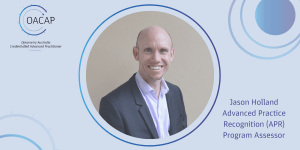1:30min
 In our recent discussion with Advanced Practice Recognition (APR) Program Assessor, Jason Holland, we delved into the Program’s achievements and challenges, gaining valuable insights into how Jason sees the Program shaping the future of optometry in Australia.
In our recent discussion with Advanced Practice Recognition (APR) Program Assessor, Jason Holland, we delved into the Program’s achievements and challenges, gaining valuable insights into how Jason sees the Program shaping the future of optometry in Australia.
According to Jason, who has been a practising optometrist for almost 30 years, the Program offers participants a unique opportunity to push the boundaries of their profession and gain recognition for advanced skills.
Gaining recognition in niche areas
At its core, Jason said the APR Program allows practitioners to identify and develop expertise in a particular subset of optometry. He emphasised that while the profession traditionally focuses on refraction and vision correction, many optometrists have a deeper passion for managing eye health conditions such as glaucoma.
‘I think this Program provides a chance for optometrists to find their niche, find their real passion, complete the Program, and then receive recognition for it,’ he said.
Jason acknowledges the Program’s important role in addressing a longstanding issue in optometry: the lack of career pathways for those passionate about eye health beyond primary care.
‘Historically, practitioners driven by a desire to do more in areas like glaucoma didn’t have a clear path to recognition. This Program solves that problem, offering OA members a structured way to credential and celebrate their expertise.’
An opportunity to strengthen collaborative care
According to Jason, relationships between ophthalmologists and optometrists have historically been strong. However, communication with general practitioners (GPs) has sometimes been lacking.
Jason said he sees the Program as an opportunity to improve the collaborative management of patients with chronic conditions.
‘The Program aims to foster better collaboration not only between optometrists and ophthalmologists but also with GPs to ensure holistic patient care.
‘This Program reignites optometry to ophthalmology. It also acknowledges that when you start managing chronic diseases like glaucoma, the GP has to be involved.’
Taking the emphasis on collaboration a step further, Jason has hopes the Program will increase collaboration between optometrists.
‘Our default when we have a difficult patient is often to refer to ophthalmology, but what if we had a key group of optometrists who were credentialed and recognised?’
Jason described the Program as having the potential to introduce an intermediate step, reducing the need for referrals to ophthalmologists and creating a more efficient, cost-effective pathway for patients with lower-risk glaucoma, ultimately optimising the use of ophthalmology resources and reducing patient wait times.
What does the Program entail?
The APR Program enables practitioners to self-assess, reflect on their treatment approaches, and ensure they’re delivering evidence-based care.
In order to become credentialled, optometrists are required to have 5+ years of experience and to undergo a structured application process. Successful applicants will:
- Submit an Expression of Interest & CV
- Provide recognition of prior experience (case logs, lectures, publications, advanced certificates)
- Submit two case reports
- Demonstrate leadership competencies
- Participate in a Clinical Discussion Interview (VIVA)
According to Jason, through case logs, detailed case reports, and one-on-one interviews, participants are rigorously evaluated on their clinical decision-making and problem-solving skills. The Program’s structured process, overseen by the Governance Committee, a group of carefully selected, experienced practitioners from diverse backgrounds including representatives from both corporate and independent practice, encourages a deeper understanding of their chosen area of expertise and builds confidence in their abilities.
This ensures that credentialled optometrists meet advanced practice competency standards, providing confidence to both patients and the broader healthcare system.
What does the future hold?
Looking to the future, Jason envisions the Program expanding to include other chronic eye conditions.
‘This is just the beginning. The APR Program has the potential to recognise a wide range of areas of expertise, providing pathways for optometrists to grow professionally and contribute more meaningfully to patient care,’ he said.
Ultimately, Jason sees the APR Program as a win for practitioners, patients, and the profession, in that it not only validates the hard work of optometrists and opens up new career pathways, but also ensures the public receives high-quality care from trusted experts.
‘At the end of the day, in having this recognition, we’re going to end up with a more streamlined, collaborative profession providing better care. Importantly, we’ll also have a more robust and happy profession and be able to maintain longevity of optometrists in the workforce.’
Optometry Australia is on track to call for expressions of interest from members interested in participating in the Program in March 2025. Stay up to date with the Advanced Practice Recognition Program here, and if you would like to discuss the program further, please contact us at policy@optometry.org.au.
Tagged as: advanced practice recognition, APR